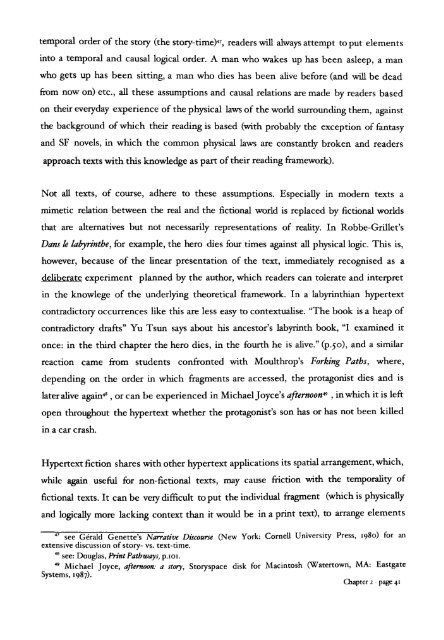From Page to Screen - WRAP: Warwick Research Archive Portal ...
From Page to Screen - WRAP: Warwick Research Archive Portal ...
From Page to Screen - WRAP: Warwick Research Archive Portal ...
Create successful ePaper yourself
Turn your PDF publications into a flip-book with our unique Google optimized e-Paper software.
temporal order of the s<strong>to</strong>ry (the s<strong>to</strong>ry-time)", readers will always attempt <strong>to</strong> put elements<br />
in<strong>to</strong> a temporal and causal logical order. A man who wakes up has been asleep, a man<br />
who gets up has been sitting, a man who dies has been alive before (and will be dead<br />
from now on) etc., all these assumptions and causal relations are made by readers based<br />
on their everyday experience of the physical lawsof the world surrounding them, against<br />
the background ofwhich their reading is based (with probably the exception of fantasy<br />
and SF novels, in which the common physical laws are constantly broken and readers<br />
approach texts with this knowledge as part oftheir reading framework).<br />
Not all texts, of course, adhere <strong>to</strong> these assumptions. Especially in modem texts a<br />
mimetic relation between the real and the fictional world is replaced by fictional worlds<br />
that are alternatives but not necessarily representations of reality. In Robbe-Grillet's<br />
Dans Ie labyrinthe, for example, the hero dies four times against all physical logic. This is,<br />
however, because of the linear presentation of the text, immediately recognised as a<br />
deliberate experiment planned by the author, which readers can <strong>to</strong>lerate and interpret<br />
in the knowlege of the underlying theoretical framework. In a labyrinthian hypertext<br />
contradic<strong>to</strong>ry occurrences like this are less easy <strong>to</strong> contextualise. "The book is a heap of<br />
contradic<strong>to</strong>ry drafts" Yu Tsun says about his ances<strong>to</strong>r's labyrinth book, "I examined it<br />
once: in the third chapter the hero dies, in the fourth he is alive." (p.so), and a similar<br />
reaction came from students confronted with Moulthrop's Forking Paths, where,<br />
depending on the order in which fragments are accessed, the protagonist dies and is<br />
lateralive again" , or can be experienced in MichaelJoyce's ajternoonr , in which it is left<br />
open throughout the hypertext whether the protagonist's son has or has not been killed<br />
in a car crash.<br />
Hypertext fiction shares with other hypertext applications its spatial arrangement, which,<br />
while again useful for non-fictional texts, may cause friction with the temporality of<br />
fictional texts. It can be very difficult <strong>to</strong> put the individual fragment (which is physically<br />
and logically more lacking context than it would be in a print text), <strong>to</strong> arrange elements<br />
47 see Gerald Genette's Narrative Discourse (New York: Cornell University Press, 1980) for an<br />
extensive discussion of s<strong>to</strong>ry- vs. text-time.<br />
48 see: Douglas, PrintPathways, p.IO!.<br />
49 Michael Joyce, afternoon: a s<strong>to</strong>ry, S<strong>to</strong>ryspace disk for Macin<strong>to</strong>sh (Water<strong>to</strong>wn, MA: Eastgate<br />
Systems, 1987).<br />
Chapter 2 - page 41





